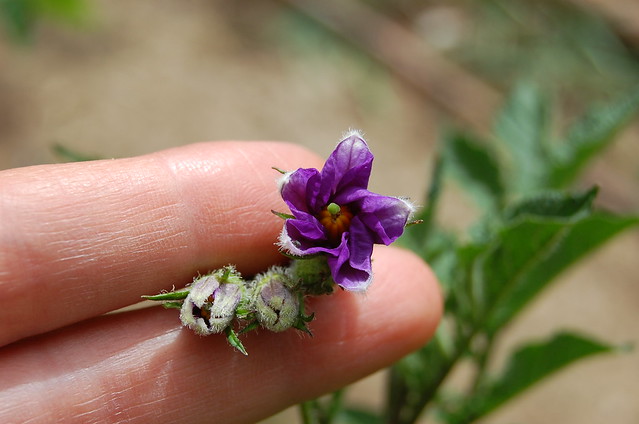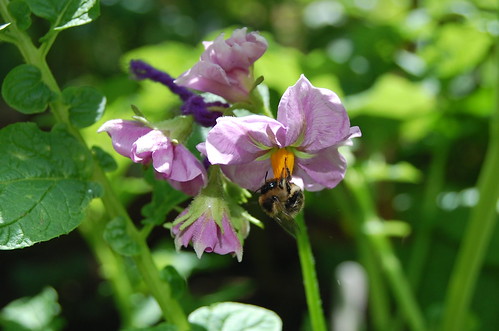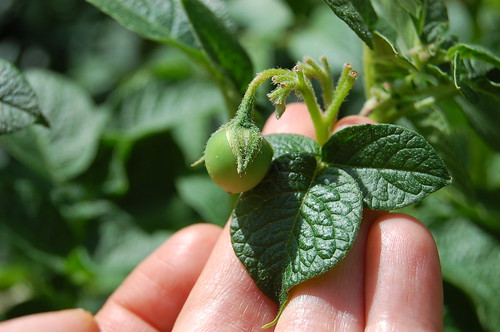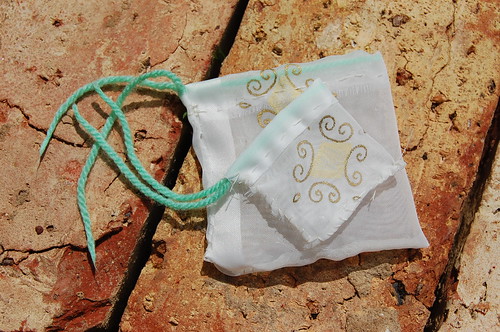
Beautiful purple potato blossom with white star points. This is seedling no.3 of Pirampo x Khuchi Akita.
My potato plants grown from TPS have started flowering, and very beautiful they are too. At the moment it's only the diploid ones which are in bloom, and although the tetraploids are starting to form buds they are a way behind.
I have two diploid lines on the go, both of them grown from hybrid seed produced by Tom Wagner and given to me by Patrick. They are Skagit Valley Gold x Thumbed Nose F1 and Pirampo x Khuchi Akita F3. Actually I also have some diploid plants from Mayan Gold OP seed I collected a couple of years ago, but those were sown a couple of weeks later than the other two and are not flowering yet.
Skagit Valley Gold is one of Tom Wagner's own varieties, derived from Andean potato lines, which makes it genetically distinct from the vast majority of American and European potatoes. It has small round tubers with orange-yellow flesh which cook very quickly, taste very special, and are high in carotenoids and Vitamin E. Thumbed Nose, its partner in this cross, is also one of Tom's own varieties but I can't tell you much about that one. I only have two plants of this hybrid and they are looking extremely unlike each other, although both have the distinctive diploid foliage. One is tall and dark-leaved with pigmentation in the veins, and hasn't flowered yet (though it has buds). The other is a bright lime green and much more compact, with little or no pigment. That one is flowering (pictured below) and the blossoms are an attractive pink mauve.

Skagit Valley Gold x Thumbed Nose F1 blossom, providing some entertainment for a bee.
The flowers on diploid potatoes look just the same as flowers on tetraploids (although they seem to have some additional colour options - I've never seen dark purple blossoms on a tetraploid) but they have some practical differences. Maybe it's to do with Tom's diligence in using only the most fertile varieties in his breeding work, but these flowers are producing stupendous amounts of pollen. As you can see in the photo, they are attractive to bees. This is interesting because bees are among the natural pollinators of potatoes but I've very rarely seen them taking an interest in regular tetraploid varieties. So prolific is the pollen production on these blossoms there were plumes of it going up like a puff of talcum powder just from the beating of the bee's wings. Needless to say I've been using the pollen to make some more crosses and a single anther is enough to pollinate pretty much everything I have available. There is just masses of it.
The other thing that's different about diploids is that they're normally self-incompatible. This inability to fertilise their own flowers is genetic, and forces them to outbreed with other potatoes. The first two blossoms on this plant fell off, unfertilised, despite the amount of pollen they were chucking around, as there was nothing else to fertilise them. Now that the Khuchi Akita hybrids are flowering I've been pollinating them with that, so hopefully I will get some berries now.
Pirampo and Khuchi Akita are both rare landraces from Bolivia. I don't know much about them, the only available information being in the records of the United States Department of Agriculture genebank, which lists them both as a "primitive cultivar". My understanding is that they have been cultivated for many generations by Bolivian farmers but have never been commercially available, and are closer to wild potatoes than to modern spuds. The appeal of this is obvious - they have diversity which would simply not be found in so-called "advanced cultivars". They are both of the Stenotomum type - that is, they're what used to be regarded as a separate species called Solanum stenotomum but which is now classified merely as a subspecies or subgroup of the standard Solanum tuberosum. Confused yet? Just look at the pretty flowers!

Pirampo x Khuchi Akita F3 blossom. This is plant no.4 in my batch, but they all have fairly similar flowers so far, varying in shades of purple and mauve.
The seeds I was given are described as being an F3. That just means that Tom has recombined the offspring a couple of times since the original cross. They have a lot of diversity, which I'm seeing more clearly because I have a number of plants ... about 15 altogether, of which eight or nine are now flowering. Most of them have flowers similar to the one shown above, a deep rich velvety purple. There are subtle variations in the purple, with some having a magenta hue and others more blue. Some have white tips on the petals. There are also some coming out mauve, again with some variation between pinky-mauve and bluey-mauve. Unfortunately the blossoms tend to be borne facing downwards, so you have to lift them up to see how beautiful they are! The plants are also varied in tallness, vigour, and the amount of colour on the stems and leaves.
I know little about the tuber characteristics of the parent varieties nor what to expect from my plants, but while I was earthing up the other day some soil fell away and I got a glimpse of a pink-skinned tuber under one of the plants, which seems to have set tubers exceptionally early. I'm not talking about the subtle rosy brick pink of a Pink Fir Apple here. I mean this one was really PINK. As in bright, vivid carmine. I left it in situ and covered it back up, but I can't wait to see what other variants these plants come up with.
I have to say, TPS is amazing stuff. The seeds are tiny and the emerging seedlings as fine as cotton threads; they have no tuber to provide them with support or nourishment. And yet in less than three months my TPS-grown plants are as large and voluptuous as most of my tuber-grown plants.
So of course I've been making a lot more hybrids for next year's seed, using various tuber-grown varieties. This berry is on a Sharpe's Express plant, pollinated with Salad Blue.

The one berry containing (I hope) F1 seeds of Sharpe's Express x Salad Blue.
Sharpe's Express is not an easy variety to make berries with, as it is a very poor flower holder. It produces very pretty flowers when it's in the mood, of a pale lilac mauve colour. But the vast majority of its buds are thrown off before they open, and I only had one cyme of mature buds this year, of which only three flowers opened. I pollinated them all very carefully with pollen from Salad Blue. Two of them fell off before they had a chance to develop into a fruit. But one - just one - successfully set a berry. I go out every day and pray for it to stay on just a little longer and not drop prematurely. Such is the tenuous nature of making hybrids with some varieties.
There are other frustrating varieties too. Negresse, which would be a wonderful variety to breed from, appears not to produce any pollen (is anyone else having any luck with it?) Its anthers are hard and sterile and I can't get anything out of them. Congo is not much better. And my Mr Little's Yetholm Gypsy is declining to flower at all this year, casting off its unopened buds with wilful profligance. But I've also had some successes. Pink Fir Apple was being a pain in the arse, producing masses of flowers but not holding them long enough for a berry to set. Through patience and persistence I've now got quite a lot of berries on it, simply by keeping on pollinating more flowers day after day. Again Salad Blue has been the primary pollinator ... as I'm tempted by the idea of knobbly blue fingerlings. Highland Burgundy Red has given me a pleasant surprise too. I've been growing it for years and it's never once set a berry for me. However I've found its female fertility to be very high - it sets berries very readily when presented with decent pollen. I assumed it was itself male-sterile, but just out of curiosity I made a couple of test crosses, using its pollen to attempt to fertilise other varieties. To my surprise I got a berry. So I tried hand-pollinating it with its own pollen, and again, one or two berries ensued. The pollen fertility doesn't seem to be as high as Salad Blue's, but it certainly can be used as a male parent as well as a female. Perhaps the reason it doesn't naturally pollinate itself is more to do with flower physiology. It has an exceptionally long pistil which sticks way out of the end of the flower, and it also has very small compact anthers. Maybe the distance between the anthers and the stigma is just too great to enable self-pollination without assistance.
So I now have quite a lot of swelling berries on a great many of my different potato plants, all hand-pollinated and marked with colour-coded wool to identify the fathers. However, there is something I will have to watch out for. The berries are quite visible to start with but as they get heavier they tend to sag down into the foliage, and are lost from view. Some sag as far as the ground, where they're vulnerable to being nibbled at or stepped on. They also have a habit of dropping off the plant unexpectedly, which is not a problem in itself as the seeds inside will carry on maturing even when detached from the plant prematurely (within reason), but it does become a problem if there's a chance of them getting lost. If they roll away from the plant it can be difficult to be sure where they came from, and the coloured threads which identify the father varieties are very liable to get detached from them. What I need - at least for those which are most precious or easily lost - is a small and very lightweight bag to hang over the berries as they near maturity, so if they do suddenly decide to make a break for freedom I have them protected and contained. I've read about people using paper bags for this, which are certainly a cheap and convenient solution, but in the British climate that's about as much use as a chocolate teapot (and for similar reasons). They need to be weatherproof, and porous enough to let air and moisture in and out, translucent enough that I can see the berries inside and light enough not to add any extra strain on the stalks, and ideally re-usable. Here's what I came up with.

Berrybags. Not the tidiest stitching, but I think these will do the job very nicely.
They are simply made from a scrap of nylon gauze of the type that's sold for making window drapes (hence the pretty gold pattern, but that's optional) and offcuts of this kind of material can be got from fabric shops for next to nothing. I'm simply folding them over and stitching them up by hand, and very roughly, as the aesthetics don't really matter. The top edge has a piece of wool folded into it to make a drawstring, and I sealed the edges with a fray-stopping chemical goo so they don't fall to bits. They take about 15-20 minutes to make and as I'm the kind of person who never measures anything they are in several different sizes, some small enough for a single berry and some big enough for a whole cyme. The bag goes over the berry (including its coloured marker thread, to make sure that stays with the berry) and the drawstring is tied up around the stem.

19 comments:
Excellent post Rebsie - no wonder Tom's impressed with your efforts.
I admire your dedication - hand crafted bags, but how about those nylon tea bags that some tea purveyors are now using?
You definitely need to get, find, purchase, rent a bigger plot, perhaps through one of those gardenshare schemes like in trendy Transition Town Totnes: http://totnes.transitionnetwork.org/gardenshare/home . And write that book - I'll buy it!
Hope the blight, which recently appeared on my Peruvian Purple potatoes, stays away from your garden. Or ask your neighbour for the latest prophylactic product from the military-industrial complex.
Dunno what happened to the rest of that link:
http://totnes.transitionnetwork.org/gardenshare/home
Potato flowers are really beautiful. I often think that some of the flowers our food plants produce could be grown for bouquets.
It will be interesting to find out what your new varieties taste like.
Berry bags! Appropriate techinlogy, I think you could call it.
Owen - blimey, how did you know about the book? You must be psychic because I haven't told anybody about it. And I hope you're writing one too.
Nylon teabags? I've not seen those, but I imagine they would be the perfect size and weight. My addiction to Marks & Sparks Assam is clearly depriving me of the latest 'happening' trends on the teabag scene.
I'd love to get some extra land, but I have the additional problem that I struggle to manage it by myself ... the garden I've already got is a full time job. What I need is some land AND a trustworthy assistant.
Kath - indeed vegetable blossoms can be incredibly beautiful.
Ian - well, it may still be usable as a female parent. I've made a lot of test pollinations and am waiting to see if it will set berries. It has the longest-lasting flowers I've ever seen on a potato so it's taking its time!
Hi Rebsie
Cheltenham Spa must be a hip, hop and happening place - I'm sure you can find a like-minded assistant whose a dab hand with hoe and watering can. If I wasn't otherwise engaged, I'd apply. We could trade licks on the twelve string. How about some real Cheltonian chutzpah - contact the Royal Agricultural College and ask if you can have a small plot there. Or, Highgrove - you're a Garden Organic member, doing important work for the benefit of humanity. Maybe psych-folk is a typo - should read psychic folk? Good luck with da book.
And don't make any typos like I just did!
Flowers disappearing fast in the wind and rain... Next year I'll select with a view to crossing some. Edzell Blues with something to stop them disintegrating.....?
Before they got the chop, Louis XVI and Marie Antoinette wore potato flowers as a pinhole and hair ornament respectively. M-A favoured purple flowered varieties.
I have to admit, I'm envious of your success with Pink Fir Apple X Salad Blue.
I've been trying that cross in both directions for two years now with no luck. Still, I shall persist as I share your desire for knobbly blue fingerlings. At least I now know it's possible.
Well done.
Mal - that's interesting about the potato flowers as hair ornament. I might wear some myself for my next album photoshoot.
Graham - assuming the cross actually has worked and I'm not just nurturing a crop of dud berries, I'll happily send you some. I was just about to email you actually ... you were right about the red-podded peas.
Check charity shops for low cost sewing machines. I bought one when we were in London in May and shipped it home.
I have some berries on my potato plants (though they were a load of random left overs from other seed sacks so no idea what kind they are!) They went in fairly late but are HUGE and have overtaken the rest of the earlier plantings - do you think I can take the berries off and keep them indoors until they dry out now and still have viable seeds??
... on the sewing machine note - I got myself a second hand sewing machine from a carboot for £3 and i works a dream :)
I have a lovely 1960s sewing machine with a bakelite pedal, but these bags are so quick and easy to make by hand it didn't seem worth getting the machine out. I thought it would be more enjoyable to make one every now and then while I'm doing other things.
Nellie, your berries should yield viable seeds as long as they've reached a decent size before you take them off. One great blessing of potatoes is that the seeds carry on maturing after the berries are harvested, and they don't go manky and squishy like tomatoes, so you can put them somewhere safe and let them carry on maturing for a month or more. Leave them on the plant as long as you can though ...
Thanks for the help :)
I'll try to avoid the temptation of the potatoes for a bit longer!!
what a wonderfully informative post. lovely!
OK, so I've identified some of my tatties that have berrys on them, and want to give this a go out of curiosity before I try any fancy plant hanky panky - do I recover the seeds from the pods and just dry them out, or is it a bit more complicated, a la tomatoes?
I am loving your berry bag idea! I am guessing that this will also keep the birds away from the fruits. And I am loving that it is reusable.
Thanks for the information. Once very beneficial to us all. Awaited further information.
Cara Mengecilkan Perut Buncit
Manfaat Slimming Capsule
Manfaat Slimming Capsule
Manfaat Slimming Capsule
Slimming Capsule
Khasiat Gastric Health Tablet
يعتبر مصنع زجاجات مياه معدنية pet مكانًا حيويًا في صناعة المشروبات، حيث يتم تصنيع العبوات المختلفة التي تستخدم لتعبئة المياه المعدنية والمشروبات الغازية والعصائر. ويشتمل عمل المصنع على عدة مراحل، بدءًا من إنتاج الزجاجات وحتى تعبئتها بالمشروبات وتغليفها، ويعتمد ذلك على تقنيات ومعدات حديثة ومتطورة. وتتميز زجاجات المياه المعدنية بالنظافة والصحة والأمان، مما يجعلها خيارًا شائعًا للمستهلكين.
مصنع يونيفورم امن صناعى يعتبر رائدًا في عالم تصنيع الملابس التي تجمع بين الحماية والأمان في بيئات العمل الصناعية. هذا المصنع يلعب دورًا حيويًا في تلبية احتياجات العديد من الصناعات والشركات التي تعتمد على بيئات العمل الخطرة. يتميز مصنع اليونيفورم الأمن الصناعي بالتفاني في تقديم منتجات متقدمة تجمع بين التصميم الحديث والمواد المقاومة للخطر، مما يضمن سلامة وراحة العاملين. تمتاز هذه الملابس بأنها تلبي المعايير العالمية وتتوافق مع لوائح السلامة والصحة المهنية، وتُعزز من الثقة والأمان في بيئات العمل الصناعية. تصنع هذه الملابس بعناية فائقة وتخضع لاختبارات دقيقة لضمان أداءها المتفوق تحت أصعب الظروف. تجعل مصنع اليونيفورم الأمن الصناعي من الأمان والأناقة شريكين رئيسيين في بيئة العمل.
Post a Comment